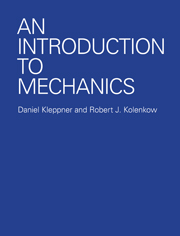Book contents
- Frontmatter
- Contents
- LIST OF EXAMPLES
- PREFACE
- TO THE TEACHER
- AN INTRODUCTION TO MECHANICS
- 1 VECTORS AND VECTORS KINEMATICS—A FEW MATHEMATICAL PRELIMINARIES
- 2 NEWTON'S LAWS—THE FOUNDATIONS OF NEWTONIAN MECHANICS
- 3 MOMENTUM
- 4 WORK AND ENERGY
- 5 SOME MATHEMATICAL ASPECTS OF FORCE AND ENERGY
- 6 ANGULAR MOMENTUM AND FIXED AXIS ROTATION
- 7 RIGID BODY MOTION AND THE CONSERVATION OF ANGULAR MOMENTUM
- 8 NONINERTIAL SYSTEMS AND FICTITIOUS FORCES
- 9 CENTRAL FORCE MOTION
- 10 THE HARMONIC OSCILLATOR
- 11 THE SPECIAL THEORY OF RELATIVITY
- 12 RELATIVISTIC KINEMATICS
- 13 RELATIVISTIC MOMENTUM AND ENERGY
- 14 FOUR VECTORS AND RELATIVISTIC INVARIANCE
- INDEX
8 - NONINERTIAL SYSTEMS AND FICTITIOUS FORCES
- Frontmatter
- Contents
- LIST OF EXAMPLES
- PREFACE
- TO THE TEACHER
- AN INTRODUCTION TO MECHANICS
- 1 VECTORS AND VECTORS KINEMATICS—A FEW MATHEMATICAL PRELIMINARIES
- 2 NEWTON'S LAWS—THE FOUNDATIONS OF NEWTONIAN MECHANICS
- 3 MOMENTUM
- 4 WORK AND ENERGY
- 5 SOME MATHEMATICAL ASPECTS OF FORCE AND ENERGY
- 6 ANGULAR MOMENTUM AND FIXED AXIS ROTATION
- 7 RIGID BODY MOTION AND THE CONSERVATION OF ANGULAR MOMENTUM
- 8 NONINERTIAL SYSTEMS AND FICTITIOUS FORCES
- 9 CENTRAL FORCE MOTION
- 10 THE HARMONIC OSCILLATOR
- 11 THE SPECIAL THEORY OF RELATIVITY
- 12 RELATIVISTIC KINEMATICS
- 13 RELATIVISTIC MOMENTUM AND ENERGY
- 14 FOUR VECTORS AND RELATIVISTIC INVARIANCE
- INDEX
Summary
Introduction
In discussing the principles of dynamics in Chap. 2, we stressed that Newton's second law F = ma holds true only in inertial coordinate systems. We have so far avoided noninertial systems in order not to obscure our goal of understanding the physical nature of forces and accelerations. Since that goal has largely been realized, in this chapter we turn to the use of noninertial systems. Our purpose is twofold. By introducing noninertial systems we can simplify many problems; from this point of view, the use of noninertial systems represents one more computational tool. However, consideration of noninertial systems enables us to explore some of the conceptual difficulties of classical mechanics, and the second goal of this chapter is to gain deeper insight into Newton's laws, the properties of space, and the meaning of inertia.
We start by developing a formal procedure for relating observations in different inertial systems.
The Galilean Transformations
In this section we shall show that any coordinate system moving uniformly with respect to an inertial system is also inertial. This result is so transparent that it hardly warrants formal proof. However, the argument will be helpful in the next section when we analyze noninertial systems.
Suppose that two physicists, α and β, set out to observe a series of events such as the position of a body of mass m as a function of time.
- Type
- Chapter
- Information
- An Introduction to Mechanics , pp. 339 - 376Publisher: Cambridge University PressPrint publication year: 2010



